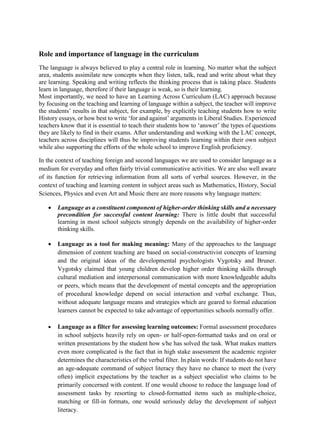
Importance of language across the curriculum
- 1. Role and importance of language in the curriculum The language is always believed to play a central role in learning. No matter what the subject area, students assimilate new concepts when they listen, talk, read and write about what they are learning. Speaking and writing reflects the thinking process that is taking place. Students learn in language, therefore if their language is weak, so is their learning. Most importantly, we need to have an Learning Across Curriculum (LAC) approach because by focusing on the teaching and learning of language within a subject, the teacher will improve the students’ results in that subject, for example, by explicitly teaching students how to write History essays, or how best to write ‘for and against’ arguments in Liberal Studies. Experienced teachers know that it is essential to teach their students how to ‘answer’ the types of questions they are likely to find in their exams. After understanding and working with the LAC concept, teachers across disciplines will thus be improving students learning within their own subject while also supporting the efforts of the whole school to improve English proficiency. In the context of teaching foreign and second languages we are used to consider language as a medium for everyday and often fairly trivial communicative activities. We are also well aware of its function for retrieving information from all sorts of verbal sources. However, in the context of teaching and learning content in subject areas such as Mathematics, History, Social Sciences, Physics and even Art and Music there are more reasons why language matters: Language as a constituent component of higher-order thinking skills and a necessary precondition for successful content learning: There is little doubt that successful learning in most school subjects strongly depends on the availability of higher-order thinking skills. Language as a tool for making meaning: Many of the approaches to the language dimension of content teaching are based on social-constructivist concepts of learning and the original ideas of the developmental psychologists Vygotsky and Bruner. Vygotsky claimed that young children develop higher order thinking skills through cultural mediation and interpersonal communication with more knowledgeable adults or peers, which means that the development of mental concepts and the appropriation of procedural knowledge depend on social interaction and verbal exchange. Thus, without adequate language means and strategies which are geared to formal education learners cannot be expected to take advantage of opportunities schools normally offer. Language as a filter for assessing learning outcomes: Formal assessment procedures in school subjects heavily rely on open- or half-open-formatted tasks and on oral or written presentations by the student how s/he has solved the task. What makes matters even more complicated is the fact that in high stake assessment the academic register determines the characteristics of the verbal filter. In plain words: If students do not have an age-adequate command of subject literacy they have no chance to meet the (very often) implicit expectations by the teacher as a subject specialist who claims to be primarily concerned with content. If one would choose to reduce the language load of assessment tasks by resorting to closed-formatted items such as multiple-choice, matching or fill-in formats, one would seriously delay the development of subject literacy.
- 2. So, language really does matter – not only in the language classroom, but across the whole curriculum. In order to understand the importance of language in school education, for all subjects and across the whole curriculum, we have to identify and summarise the basic tenets on which LAC rests. These are (cf. Corson 1990, 74): i. Language develops mainly through its purposeful use (domains to be broadened) ii. Learning (often) involves talking, writing, shaping and moving (normally in reaction to perceptions). iii. Learning often occurs through speaking or writing as much as through shaping and moving iv. Language use contributes to /is a pre‐requisite for cognitive development v. Language is the medium for reflecting on learning, for improving it, for becoming (more or less) autonomous as learners Therefore the goals of LAC are – in simple terms ‐ to support language development in each and every child, in all domains of language use, in each learning activity in school, and to give children feedback about their progress (through appropriate assessment and evaluation). LAC is no longer narrowly seen as the exclusive domain of L1/LS education nor is it confined solely to the conventional four modes of language: Reading, Writing, Listening and Speaking; all non‐ verbal means of representation and expression are rightly seen as part of the overall semiotic systems that we have at hand and that we use when communicating. The whole scope of semiotics comes into focus including images or graphs, movements and, generally speaking, all visual forms of representation and expression (cf. Corson 1990: 72). Thus, we can distinguish eight modes of human activities involving language, namely: • Listening: comprehending oral input/intake • Speaking: constructing meaningful utterances • Reading: understanding written texts • Writing: producing written texts/coherent discourse • Viewing: attending to visual signs/information • Shaping: using visual means of expression • Watching: attending to physical movements • Moving: using the whole body, the whole person for self‐expression. Consequently, all teachers are encouraged to participate in developing language skills and competences within their fields of responsibility and thus contribute to a school learning policy as a whole. In summary one can state the following beliefs: • Language is more than communication skills • Language is also linked to the thinking process • Language is a tool for conceptualising, for thinking, for networking • Language supports mental activity and cognitive precision • Language for academic purposes helps to express thoughts more clearly (this is especially true for writing) • Language helps to structure discourse and practise discourse functions
